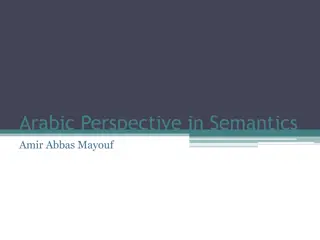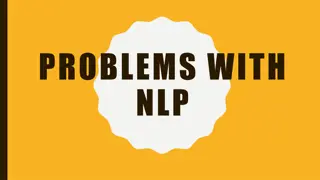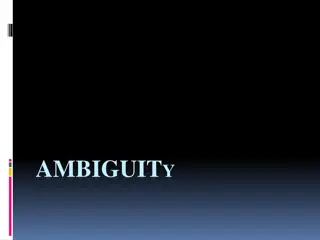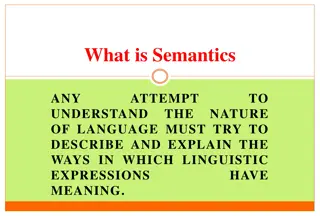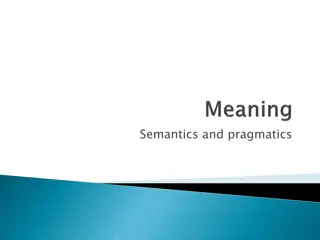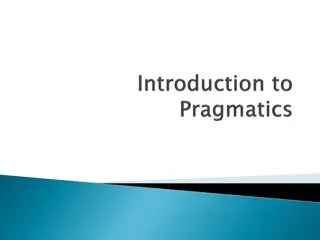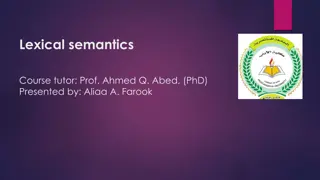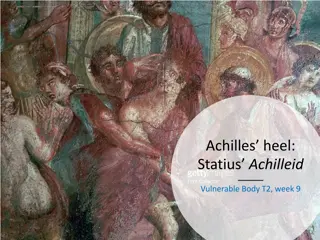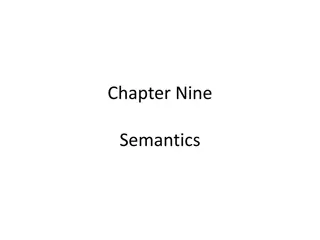Ambiguity and Expressive meaning in semantics.
Presenting the concept of ambiguity and expressive meaning in semantics, discussing types of ambiguity such as lexical and structural ambiguity, alongside examples and insights on differentiation from descriptive meaning. Explore the nuances of language through deictic expressions, multiple senses in phrases, and the properties that distinguish expressive meaning. Dive into case studies and illustrations to grasp the complexities of linguistic interpretation further.
Download Presentation

Please find below an Image/Link to download the presentation.
The content on the website is provided AS IS for your information and personal use only. It may not be sold, licensed, or shared on other websites without obtaining consent from the author.If you encounter any issues during the download, it is possible that the publisher has removed the file from their server.
You are allowed to download the files provided on this website for personal or commercial use, subject to the condition that they are used lawfully. All files are the property of their respective owners.
The content on the website is provided AS IS for your information and personal use only. It may not be sold, licensed, or shared on other websites without obtaining consent from the author.
E N D
Presentation Transcript
Ambiguity and Expressive meaning in semantics. Presented by: Manar Thabit Salih Coures Touter: Prof. Ahmed Q. Abed
Table of contents: Ambiguity. Expressive meaning: Ouch and oops. The properties which distinguish Expressive meaning from descriptive meaning: Independence Nondisplaceability. Immunity. Scalability and repeatability. Descriptive ineffability. Case study: Expressive uses of diminutives.
Ambiguity: What is Ambiguity ? * a Word, a phrase or a sentence is ambiguous if it has more than one sense . For examples: Can you give me a hand? The body part I`m asking for her hand. The group of cards held by a player A bunch of a banana Hand a pointer of a clock A hired worker Asking to marry
Ambiguity: A deictic expression will refer to different individuals when spoken by different speakers, but this does not make it ambiguous. For example: I love my father. A word or a phrase can have different denotations in differentcontexts does not mean that it has multiple senses. but this does not make it ---ambiguous. For examples: The president of the United State visits Iraq. The 46th president of the united state is Joe Biden. In 2008, the president of the United State is Barak Obama.
Kinds of ambiguity: 1- Lexical ambiguity: If a phrase or a sentence contains an ambiguous word, a phrase or a sentence will normally be ambiguous as well. For example: A boiled egg is hard to beat. defeat surpass difficult not soft For example: I just turned 80 years old and I have a happy family. Only now A sentence which has only a single sense may have different truth of values in different contexts, but will always have one consistent truth value in any specific context. For examples: I`m looking for my glasses. I`m looking for my glasses to read the newspaper. I`m looking for my glasses to drink some water.
Kinds of ambiguity: 2- Structural ambiguity: An ambiguous sentence have two or more senses (or readings) arise because the grammar of the language can assign two different structures to the same string of words, even though none of those words is itself. some sentences involve both structural and lexical ambiguity. For example: *Two cars were[ reported [stolen by the Groveton police]] yesterday. * One morning, I [shot an elephant] [in my pajamas]. * One morning, I shot [an elephant in my pajamas] take a photo killed Structural ambiguity shows us something important about meaning, namely that meanings are not assigned to strings of phonological material but to syntactic objects. The two readings for involve the same string of words but not the same syntactic object.
Kinds of ambiguity: 3- Referential ambiguity: It is common that people using pronouns in a way that permits more than one possible antecedent. e.g. Adams wrote frequently to Jefferson while he was inParis. For example: If I am teaching a class of 14 students, and I say to the school manager [My student] has taken a full mark in the exam, there are multiple possible referents for the subject NP.
Expressive meaning: Ouch and oops * words such as Ouch and oops convey a kind of meaning is called expressive meaning, which Lyons (1995: 44) defines it as the kind of meaning by virtue of which speakers express, rather than describe, their beliefs, attitudes and feelings. Expressive meaning is different from descriptive meaning (also called propositional meaning or truth- conditional meaning), the normal type of meaning which determines reference and truth values. * words such as Ouch and oops often referred to expressive, present a challenge to the denotation approach. They neither refer to thing in the world, nor help to determine the condition under which the sentence to be true. For example: If I hurt myself when I am working alone, I will very likely say ouch even though there is no one present to hear me. they may not necessary to be attended to communicate. Such expressions seem almost like involuntary reactions.
Expressive meaning: Ouch and oops many normal words carry both types of meaning at once. for example: the word garrulous means essentially the same thing as talkative, but carries speaker s negative attitude. There are many other pairs of words which convey the same descriptive meaning but differ in terms of their expressive meaning such as: father vs. dad; woman vs. broad; horse vs. nag; alcohol vs. booze; etc. In each case either member of the pair could be used to refer to the same kinds of things in the world; the speaker s choice of which term to use indicates varying degrees of intimacy, respect, appreciation or approval, formality, etc.
The properties which distinguish Expressive meaning from descriptive meaning: 1- Independence: Expressive meaning is independent of descriptive meaning in the sense that expressive meaning does not affect the denotation of a noun phrase or the truth value of a sentence. For example, the addressee might agree with the descriptive meaning of without sharing the speaker s negative attitude indicated by the expressive term `jerk`. That Jerk Peterson work in the company with us 2 Nondisplaceability: Hockett (1958; 1960) used the term Displacement to refer to the fact that speakers can use human languages to describe events and situations which are separated in space and time from the speech event itself. Hockett listed this ability as one of the distinctive properties of human language which distinguishes than animal communication. Cruse (1986: 272) notes that this capacity for displacement holds only for descriptive meaning, and not for expressive meaning. A person can describe his own feelings in the past or future. e.g. Last month I felt a sharp pain in my chest. e.g. I will probably feel a lot of pain when the dentist drills my tooth tomorrow. or the feelings of other people, e.g. She was in a lot of pain. But when a person says Ouch!, it must normally express pain that is felt by the speaker at the moment of speaking.
The properties which distinguish Expressive meaning from descriptive meaning: 3- Immunity: Descriptive meaning can be negated, questioned, or challenged. Expressive meaning is immune to all of these things. The fact that expressive meaning cannot be negated, questioned, or challenged shows that it is not part of the truth-conditional meaning of the sentence. a. I am not feeling any pain . b. b. Are you feeling any pain? c. c. patient: I just felt a sudden sharp pain. dentist: That s a lie I gave you a double dose of Novocain.(Cruse 1986: 271) . a. *Not ouch. b. *Ouch? (can only be interpreted as an elliptical form of the question: Did you say Ouch ?) c. patient: Ouch! dentist: #That s a lie.
The properties which distinguish Expressive meaning from descriptive meaning: 4 -Scalability and repeatability Expressive meaning can be intensified through repetition or by the use of intonational features such as pitch, length or loudness. Descriptive meaning is generally expressible in discrete units which correspond to the lexical semantic content of individual words. Repetition of descriptive meaning tends to produce redundancy, though we should note that a number of languages do use reduplication to encode plural number, repeated actions, etc.
The properties which distinguish Expressive meaning fromdescriptive meaning: 5-Descriptive ineffability: Effability means expressibility . The effability hypotheses claims that Each proposition can be expressed by some sentence in any natural language or Whatever can be meant can be said. Uses the phrase descriptive ineffability to indicate that expressive meaning often cannot be adequately of descriptive meaning. A paraphrase based on descriptive meaning (e.g. young dog for puppy) is often interchangeable with the original expression, Referring, denoting, and expressing is true, must be true as well, and vice versa. This substitution is equally possible in questions, commands, negated sentences, etc. This is not the case with expressive, even where a descriptive paraphrase is possible, e.g.: a. Yesterday my son brought home a puppy. b. Yesterday my son brought home a young dog.
The properties which distinguish Expressive meaning fromdescriptive meaning: For many expressives there is no descriptive paraphrase available, and speakers often find it difficult to explain the meaning of the expressive form in descriptive terms. For example, most dictionaries do not attempt to paraphrase the meaning of oops , but rather define it by describing the contexts in which it is normally used: a. used typically to express mild apology, surprise, or dismay b. an exclamation of surprise or of apology as when someone drops something or makes a mistake This limited expressibility correlates with limited translatability. well known example is the ancient Aramaic term of contempt raka , which appears in the Greek text of Matthew 5:22 (and in many English translations), because there is no adequate translation equivalent in Greek. (Some of the English equivalents which have been suggested include: good-for nothing, rascal, empty head, stupid, ignorant.) In 393 AD, St. Augustine offered the following explanation: the word does not mean anything, but merely expresses the emotion of an angry mind. Grammarians call those particles of speech which express an affection of an agitated mind Interjections, ; as when it is said by one who is grieved. Alas, or by one who is angry, Hah. And these words in all languages are proper name.
The properties which distinguish Expressive meaning fromdescriptive meaning: 6- Case study expressive use Diminutives: Expressive uses of diminutives,Diminutives are grammatical markers whose primary or literal meaning is to indicate small size; but diminutives often have secondary uses as well, and often these involve expressive content. Anna Wierzbicka (1985) describes one common use of diminutives as follows : Warm hospitality is expressed as much by the use of diminutives as it is by the style of offers and suggestions. Characteristically, the food items offered to the guest are often referred to by the host by their diminutive names. Take some more dear-little-herring (dim). You must ! The diminutive praises the quality of the food and minimizes the quantity pushed onto the guest s plate. The speaker insinuates: Don t resist!
References: Paul R. Kroeger((2019,p23-30):analyzing meaning) Lyons (1995: 44) Hockett (1958; 1960) Cruse (1986: 272) 393 AD, St. Augustine 393 AD, St. Augustine Matthew 5:22 Anna Wierzbicka (1985) Groucho Marx(1890-1977)





